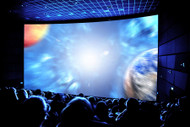The Importance of Choosing the Right Screen for Laser Projectors & 3D Systems
Posted by Julio Urbay on 25th May 2025
The Importance of Choosing the Right Screen for Laser Projectors & 3D Systems
Selecting the right cinema screen is critical for delivering an exceptional moviegoing experience, especially when using laser projectors and 3D systems. The screen directly affects brightness, contrast, color accuracy, and depth perception, making it a vital component of immersive cinema technology.
Why Screen Type Matters for Laser Projectors
Laser projectors provide higher brightness, superior color accuracy, and longer lifespan compared to traditional lamp-based systems. However, they can produce speckle effects, particularly with RGB pure laser projection. To minimize this issue, theaters should use matte white screens or specialized ambient light-rejecting (ALR) screens that enhance contrast while reducing unwanted artifacts.
Optimizing Screens for 3D Projection
3D projection requires screens that preserve polarization and maintain brightness levels. Silver screens are commonly used for passive 3D systems, such as RealD 3D and Dolby 3D, because they help retain the required polarization. However, silver screens can cause hot spots and have limited viewing angles, so strategic placement and calibration are crucial.
Fusion Superplex – A Case Study in Advanced Screen Technology
Fusion Superplex in the Bahamas serves as an excellent real-world example of how advanced screen choices elevate the cinematic experience. The complex features IMAX with Laser, 4DX, and Pure V.I.P. auditoriums, each requiring carefully selected screens to complement the cutting-edge projection technologies used in these premium formats.
- IMAX with Laser – This high-brightness projection system benefits from custom-engineered screens that amplify clarity, contrast, and color accuracy. The massive screen size ensures fully immersive visuals, with deep blacks and vibrant tones.
- 4DX Theaters – The motion-enhanced experience of 4DX demands specialized screens that accommodate movement while maintaining image stability and brightness, ensuring an uninterrupted multi-sensory experience.
- Pure V.I.P. Auditoriums – High-end viewing spaces require high-gain screens that enhance brightness and contrast, delivering a premium viewing experience for discerning audiences.
Key Considerations for Cinema Screens
To ensure optimal performance for laser projection and 3D systems, consider the following factors:
- Gain & Brightness: Higher-gain screens reflect more light, improving brightness but potentially causing uneven illumination.
- Contrast & Black Levels: ALR screens enhance contrast, making dark scenes more vivid and realistic.
- Viewing Angles: Wide-angle screens ensure uniform image quality from every seat in the auditorium.
- Acoustic Transparency: Perforated screens allow sound to pass through, maintaining clear audio from behind-the-screen speakers.
Best Screen Choices for Modern Cinemas
For laser projection, premium matte screens like Draper TecVision XT1000X White or XH700X Grey help reduce speckle and maximize image clarity. For 3D systems, high-quality silver screens from manufacturers like Harkness Screens support optimal brightness and polarization retention.
By integrating the right screen technology, cinemas can maximize the potential of laser projection and 3D systems, ensuring audiences enjoy crystal-clear visuals, immersive depth, and superior contrast—just as Fusion Superplex has demonstrated.

